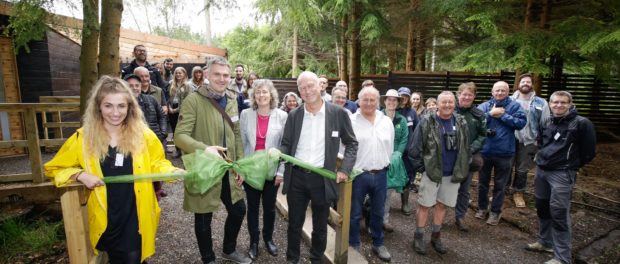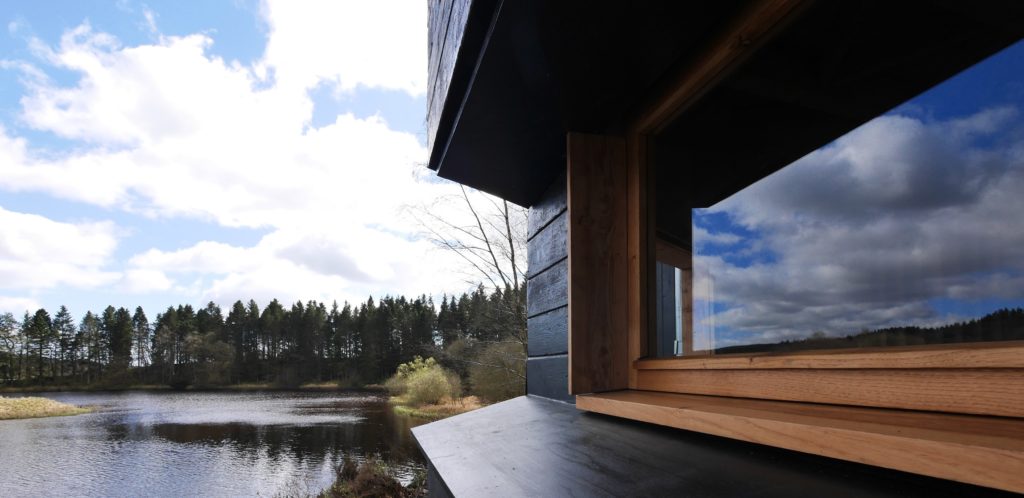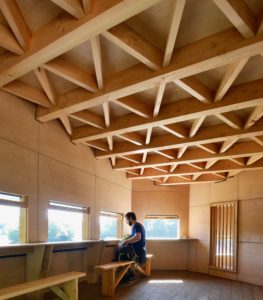Newcastle University students design and build new nature hide

A wonderful, new, wildlife hide has recently been designed and built on the shores of Kielder’s Bakethin Nature Reserve in Northumberland by University of Newcastle MArch (Master of Architecture) students.
If you want to get up-close to British wildlife in its natural state, then head here and prepare to be amazed.
The award-winning Kielder Water & Forest Park contains England’s largest working forest and the largest man-made lake in Northern Europe. It is home to England’s largest red squirrel population and in 2009, ospreys returned to the area following an absence of more than 200 years in Northumberland.
Over the last two years, nine students from the University of Newcastle School of Architecture have worked closely with Kielder Water & Forest Park Development Trust through its Art & Architecture programme, alongside Northumberland Wildlife Trust and Northumbrian Water to create the project. They developed several designs from which the project partners selected their preferred option. Students were supported by staff from partner organisations, employees and technicians at Newcastle University School of Architecture, Planning and Landscape, and by Northumberland Wildlife Trust volunteers.
Now all manner of flora, fauna and feathered creatures can be spied from the vast, clear viewing areas of the new Bakethin Hide. It’s a very peaceful place to be.
Bakethin Hide comprises two, spacious, timber-built, hexagonal pods – the “lake view” which offers the more experienced birdwatcher a more elevated view of the osprey nesting pole and upper lake, and the “forest view” which gives full views of the lake and the lower forest view.
Although the two pods are on different levels, both are fully accessible. In addition, wheelchair users can enjoy exactly the same experience thanks to carefully designed space under window ledges.
Each separate room contains boards providing information on the birds and animals that are likely to be seen from the hide throughout the year – as well as a blackboard and visitors book for sightings.

 The large horizontal, glazed sash windows can be safely and easily raised so people can feel they’re actually out there, amongst it all.
The large horizontal, glazed sash windows can be safely and easily raised so people can feel they’re actually out there, amongst it all.
Beyond the hide, two screening walls extend along the lakeside and into the forest, reducing the impact of visitors on wildlife and helping to provide an undisturbed viewing experience once inside.
Over the past five years, Kielder Water & Forest Park Development Trust and Newcastle University School of Architecture have delivered a series of unique projects in collaboration with remote communities and smaller organisations in Kielder Water & Forest Park.’
Past projects have shown that providing opportunities for students to develop their design and public-facing skills by working on live build projects with real clients offers a significant and valuable addition to their studies that the university recognises and strongly supports.
Following the success of previous projects within this programme, students are now applying to the Newcastle University MArch course specifically because of the opportunity to work on a live project design and build.
Three of the nine students working on Bakethin Hide chose to study at Newcastle for their MArch degree, having taken BA degrees at other universities, specifically because of the opportunity to take part in the live build project. The other six students had all opted to take their BA degrees at Newcastle and chose to stay for their MArch because of this opportunity.
The skills and knowledge which the students learned went beyond simple design and construction skills and offered invaluable “on the job” experience such as negotiating with suppliers; understanding the roles of other professions in the construction process; the contrast between precise design drawings and the realities of construction; planning for health and safety; and managing lead-in times for ordering and delivery, all nine students received a distinction for this module.
Student Katie Fisher said: “This project has given me a step forward in my career, an opportunity to get ahead and a better understanding of how a building comes together. When I detail a building again, I will be able to look back on this experience, think about how we went about this project and how it might affect a project in the future.”
Student Sam Halliday said: “Learning how to go from wanting to design and draw something beautiful, to being on site and trying to practically construct the project is a completely different ball game!”
Professor Graham Farmer, Director of Architecture at Newcastle University said: “The completion of Bakethin Hide demonstrates the School’s ongoing commitment to offering an architectural education that provides opportunities for students to learn by doing. The project has been challenging and the students have had to navigate complex statutory, client and user requirements as well as developing a range of new design and construction skills. The quality of the finished structure is testament to their commitment and enthusiasm.”
Peter Sharpe, Art & Architecture Curator for Kielder Water & Forest Park Development Trust, said: “As well as being a key element of the Living Wild at Kielder project, Bakethin Hide is part of our Testing Ground programme, which enables us to commission innovative architectural pieces that are also invaluable learning tools for architecture students, providing them with design and construction experience and helping to develop their communication and negotiation skills with real clients.”
Lynn Turner, Director of the Kielder Water & Forest Park Development Trust, said: “Bakethin Hide been a fantastic project for all concerned and we have enjoyed working together with the students and our partners on it. We feel it will be of a huge benefit to the local community and to visitors and will provide a fantastic vantage point for nature lovers for years to come.”

